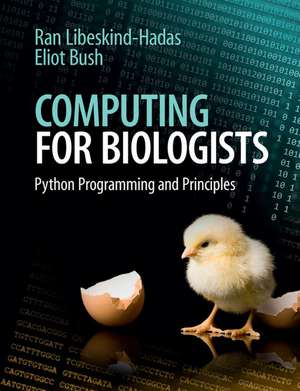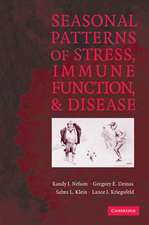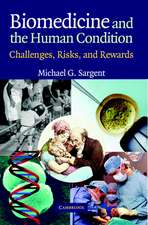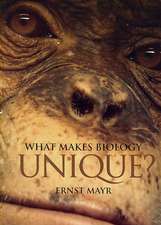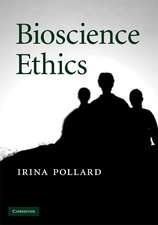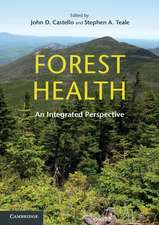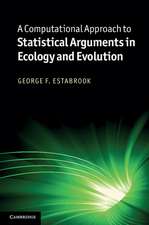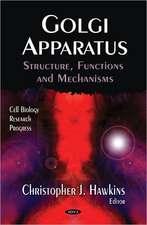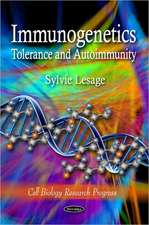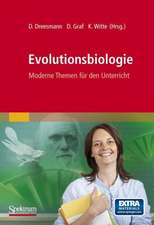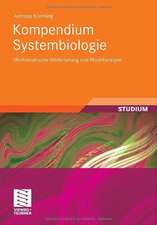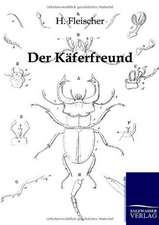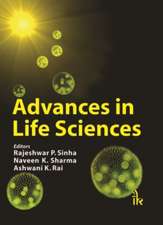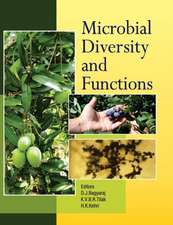Computing for Biologists: Python Programming and Principles
Autor Ran Libeskind-Hadas, Eliot Bushen Limba Engleză Paperback – 21 sep 2014
Preț: 396.41 lei
Nou
Puncte Express: 595
Preț estimativ în valută:
75.88€ • 82.45$ • 63.78£
75.88€ • 82.45$ • 63.78£
Carte disponibilă
Livrare economică 31 martie-14 aprilie
Preluare comenzi: 021 569.72.76
Specificații
ISBN-13: 9781107642188
ISBN-10: 1107642183
Pagini: 218
Ilustrații: 8 b/w illus. 33 colour illus. 1 table
Dimensiuni: 190 x 247 x 10 mm
Greutate: 0.5 kg
Editura: Cambridge University Press
Colecția Cambridge University Press
Locul publicării:New York, United States
ISBN-10: 1107642183
Pagini: 218
Ilustrații: 8 b/w illus. 33 colour illus. 1 table
Dimensiuni: 190 x 247 x 10 mm
Greutate: 0.5 kg
Editura: Cambridge University Press
Colecția Cambridge University Press
Locul publicării:New York, United States
Cuprins
Preface; Meet python; Part I. Python versus Pathogens: 1. Computing GC content; 2. Pathogenicity islands; 3. Open reading frames and genes; 4. Finding genes (at last!); Part II. Sequence Alignment and Sex Determination: 5. Recursion; 6. The use-it-or-lose-it principle; 7. Dictionaries, memoization, and speed; 8. Sequence alignments and the evolution of sex chromosomes; Part III. Phylogenetic Reconstruction and the Origin of Modern Humans: 9. Representing and working with trees; 10. Drawing trees; 11. The UPGMA algorithm; Part IV. Additional Topics: 12. RNA secondary structure prediction; 13. Gene regulatory networks and the maximum likelihood method; 14. Birds, bees, and genetic algorithms; Where to go from here; Index.
Recenzii
'In my twenty years as a professor, I have never run across a textbook on bioinformatics algorithms that a biologist can read from cover to cover and understand. This is the one.' Pavel Pevzner, Ronald R. Taylor Distinguished Professor of Computer Science, University of California, San Diego
'This is an awesome book for anyone to get into computing. It is easy to follow and clearly structured so the reader understands what they are learning and why. The book provides the fundamentals concepts of computational biology and bioinformatics in parallel to gaining actual skills in computing and the ability to write your own Python programs! What I love about the book is how the authors ensure the concepts and skills are applicable to a clear and defined biological problem. The authors help demystify the various topics and bring the reader to understand the algorithms behind the programming tools by applying these to resolve an actual biological problem. This book is also an excellent resource for those involved in training and education, and it provides plenty of exercise to use in the actual classroom.' Maria Victoria Schneider, The Genome Analysis Centre (TGAC), UK
'There is a wide agreement that biological science curricula should change and that a better understanding of computational notions and practice is required, starting at undergraduate level. Only a handful of academic programs, and fewer textbooks, are offering such computational experience to life science students, beyond a general introductory programming course. Libeskind-Hadas and Bush take a novel, exciting approach to this challenge. They designed an introductory programming and computer science principles course, using Python, and built around a carefully selected suit of computational problems with a biological motivation. The book covers all basic notions and programming practices that are taught in standard CS introductory course, and even adds some advanced computational ideas. Most importantly, it will be far more friendly and relevant to the vast majority of life science students, who are likely to discover through it both the beauty of computer science and its relevance to their own discipline.' Benny Chor, Tel-Aviv University, Israel
'This is an awesome book for anyone to get into computing. It is easy to follow and clearly structured so the reader understands what they are learning and why. The book provides the fundamentals concepts of computational biology and bioinformatics in parallel to gaining actual skills in computing and the ability to write your own Python programs! What I love about the book is how the authors ensure the concepts and skills are applicable to a clear and defined biological problem. The authors help demystify the various topics and bring the reader to understand the algorithms behind the programming tools by applying these to resolve an actual biological problem. This book is also an excellent resource for those involved in training and education, and it provides plenty of exercise to use in the actual classroom.' Maria Victoria Schneider, The Genome Analysis Centre (TGAC), UK
'There is a wide agreement that biological science curricula should change and that a better understanding of computational notions and practice is required, starting at undergraduate level. Only a handful of academic programs, and fewer textbooks, are offering such computational experience to life science students, beyond a general introductory programming course. Libeskind-Hadas and Bush take a novel, exciting approach to this challenge. They designed an introductory programming and computer science principles course, using Python, and built around a carefully selected suit of computational problems with a biological motivation. The book covers all basic notions and programming practices that are taught in standard CS introductory course, and even adds some advanced computational ideas. Most importantly, it will be far more friendly and relevant to the vast majority of life science students, who are likely to discover through it both the beauty of computer science and its relevance to their own discipline.' Benny Chor, Tel-Aviv University, Israel
Notă biografică
Descriere
This book teaches life science students how to use Python programming and computational problem-solving in the context of compelling biological applications.
